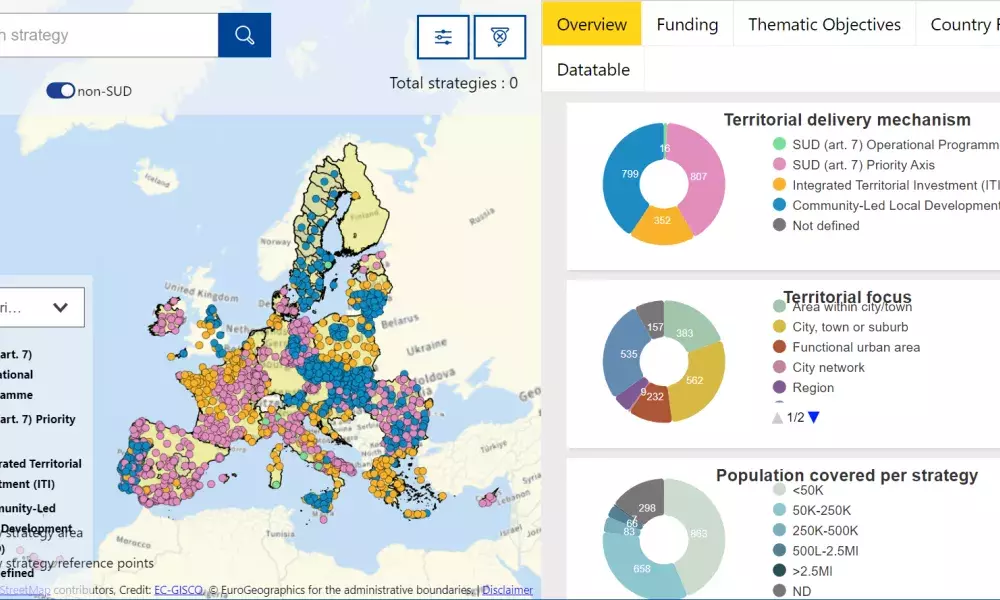
Text
STRAT-Board is an interactive tool developed by the Joint Research Centre (JRC) and DG REGIO under the umbrella of the Knowledge Centre for Territorial Policies. It aims to provide a continuously updated state of play on how European Structural and Investment Funds (ESIF) support the integrated approach to urban and territorial development by offering a visual overview of Sustainable Urban Development (SUD), Integrated Territorial Investment (ITI) and Community-led Local Development (CLLD) strategies implemented across Europe within Cohesion Policy 2014-2020.
The tool enables the exploration of investment strategies by different perspectives such as geographical unit, spatial focus, thematic concentration, size of population, funding arrangements and implementation mechanisms.
STRAT-Board is an interactive tool developed by the Joint Research Centre (JRC) and DG REGIO under the umbrella of the Knowledge Centre for Territorial Policies. It aims to provide a continuously updated state of play on how European Structural and Investment Funds (ESIF) support the integrated approach to urban and territorial development by offering a visual overview of Sustainable Urban Development (SUD), Integrated Territorial Investment (ITI) and Community-led Local Development (CLLD) strategies implemented across Europe within Cohesion Policy 2014-2020.
The tool enables the exploration of investment strategies by different perspectives such as geographical unit, spatial focus, thematic concentration, size of population, funding arrangements and implementation mechanisms.
STRAT-Board is primarily designed as a policy support tool aiming to provide a complete overview of Sustainable Urban Development (SUD), Integrated Territorial Investment (ITI) and Community-led Local Development (CLLD) strategies implemented in EU Member States with the support of the Cohesion Policy funds during the 2014-2020 programming period. CLLD strategies are limited to those currently programmed under the European Regional Development Fund (ERDF) and the European Social Fund (ESF).
Data has been collected as follows.
First, the STRAT-Board knowledge base was built upon the DG REGIO study Integrated Territorial and Urban Strategies; how are ESIF adding value in 2014-2020? (EPRC, 2017), which has identified over 1,000 strategies across EU, representing a first effort to build an extensive pan-European database of strategies supported by EU territorial tools. Given that the study was finalized almost midway the programming period, not all identified strategies had been officially approved. Also, the study reports that there remains some uncertainty about the final number of strategies because of competitive selection processes, absent or conflicting information, and/or delays in the implementation process.
In a second moment, in order to update, complement and verify the available data, the JRC launched a survey to all responsible Managing Authorities late February 2018. The survey included around 35 structured questions (in English), for which some information was already pre-filled with EPRC data. Managing Authorities were asked to check the pre-filled data, fill in the gaps, and to add or remove strategies when needed. The surveys were sent out in different batches depending on the time it took to prepare them. The survey has been finalised in December 2018. Because of language barriers and difficulty in identifying the Managing Authorities, data for Greece were collected by a subcontractor.
CLLD data were collected by a subcontractor in December 2019, complementing and verifying the data collected for DG REGIO in 2018: CLLD under ERDF/ESF in the EU: A stock-taking of its implementation (Servillo, 2018).
In order to retrieve missing data, and update existing information, in November 2020 a new survey to all Managing Authorities was launched. The survey included around 50 structured questions (in English), replicating in most cases the previous survey, with pre-filled information, and including a number of new questions. Managing Authorities were asked to check the pre-filled data, fill in the gaps, and to add or remove strategies when needed. Considerable attention was put on the territorial coverage of the strategy areas.
Territorial coverage of strategies has been elaborated based on the surveys, leading to the definition of the location and perimeter of each strategy according to geographical units as LAU2, City, NUTS2, NUTS3, NUTS1. All SUD strategies and non-SUD strategies implemented by means of ITI and CLLD have been validated with information on territorial coverage and can be identified as geo-referenced maps. The survey was finalised in January 2021. In 2021, the territorial coverage of CLLD strategies was further verified by a subcontractor.
For some strategies, even after survey data had been received, information was not sufficiently clear and/or available. In these cases, publicly available strategy documentation, and/or additional sources, such as the Open Cohesion Data portal for the European Structural and Investment Funds, have been searched. Still, in a few number of cases information is missing.
Finally, it is important to note that the data collection process is ongoing: Managing Authorities (and/or other relevant actors) are encouraged to submit new or updated data for the strategies they are responsible for at any time. For the country fact sheets, we have relied on all sources named above, plus three other main sources, being:
- EUKN (2017) Ten years after the Leipzig Charter. The enduring relevance of integrated urban development in Europe, Federal Institute for Research on Building, Urban Affairs and Spatial Development (BBSR) within the Federal Office for Building and Regional Planning (BBR), Bonn;
- OECD (2017) National Urban Policy in OECD countries, OECD publishing, Paris;
- CLGF (2018) CLGF Commonwealth Local Government Handbook 2017/18.
For the strategy fact sheets, information from the Urban Development Network, URBACT and Urban Innovative Actions has been included to provide direct links to SUD implementation projects and other relevant EU initiatives.
About this resource
The Joint Research Center – Territorial development unit supports the territorial articulation of the EU policy agenda, its external investment and global outreach. Our aim is to deliver world-class science-for-policy support to bring Europe closer to citizens and places, turning territorial diversity into value.
Similar content




